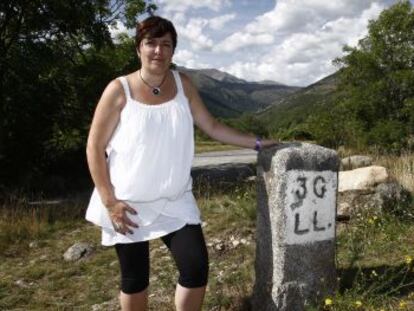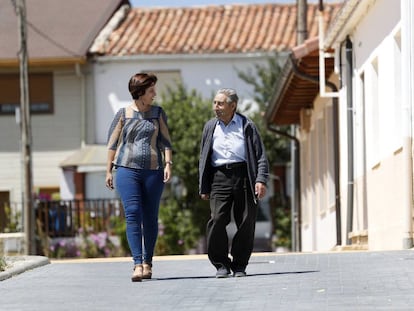Influx of liberal professionals transforms a sleepy Spanish hamlet
A doctor from Argentina bought a crumbling house in Pinilla de Ambroz 20 years ago, and was followed by a flow of college professors, architects and artists from all over the world

Some 27 kilometers from the Spanish city of Segovia, there is a hamlet with around 40 homes named Pinilla de Ambroz. It is just one of many semi-abandoned villages that dot Spain’s inland regions, a place where its precious few residents – 29 in 2017, according to the National Statistics Institute – make a living from agriculture.
But something has changed in the local demographics. There is a growing group of highly educated, part-time residents in Pinilla – university professors, artists, architects, doctors and lawyers – who have come here from all parts of the world to buy summer homes.
It was pure luck the way I arrived here
Susana Sparacino, retired physician
And it all started with Susana Sparacino. A retired physician from Argentina, she bought a property here over 20 years ago, sparking a repopulation movement in Pinilla.
“It was pure luck the way I arrived here: I knew a lady who was selling her house and I bought it in order to spend weekends here with my children,” she explains. At first, visiting friends told her that she was crazy. But later they changed their tune to: “If you hear of something [for sale], let me know.”
Sparacino says there are now more foreigners than locals in town. “This is like the United Nations, there are people from all over the world,” she explains inside her garden, which is filled with flowers.
Out on the streets, there are more cats than people around. A breeze cools down a group of elderly men playing cards in the shade. The temperature in Pinilla is typically 5ºC lower than in Madrid. There are “For Sale” signs on the doors of crumbling homes, but not as many as there used to be.
Anyone is welcome to come here
Mayor Juan José de Frutos
Over the years, more than 20 people from different parts of the world have bought property in Pinilla. They come from Switzerland, Argentina, Colombia, France and the United States, among other countries. And they have created a community of friends at an age when most people stop making friends.
“We are all interested in art, society and politics,” notes Enrique Ogliastri, who teaches at the Madrid business school IE and who was once part of the faculty at Harvard University. Ogliastri, who is originally from Colombia, has also authored more than 30 books, and he was looking for a quiet place to write. His wife, Emma Cecilia Ferreira, also wanted some place where she could devote herself to her sculptures.
As luck would have it, Ogliastri ran into an old schoolmate, Aníbal Alfaro, while at Cambridge. Alfaro had worked for three decades as an architect at Harvard Square, where he met his wife Prudence, a Spanish teacher. They, too, were looking for a nice place to retire. Now they spend most of their summers in Pinilla.
Three houses down from them is Ignacio Gómez-Pulido, born in Colombia and nationalized French. The entrance to his home features iron-wrought sculptures that gleam in the sun. He has made them himself. “This used to be nothing more than four walls and a caved-in roof,” he says, pointing at the house. The second floor now contains an entire photography lab. “I brought it over from Paris. This lifestyle is completely different from the one I lead there; it’s a different pace, a different way of looking at things.”
If you close your eyes, there is complete silence
Madeleine Rodríguez, translator
Over time, the new residents have influenced one another, taking up their neighbors’ hobbies. Álvaro Torres spends his mornings painting, and his husband Fausto Gonzaga believes that if it were not for this group of people, they themselves would not spend their summers in Pinilla de Ambroz. He doesn’t like the village, but he likes the people. “They are very open, very cultured, and that plays a role,” he says.
Gonzaga is not the only person to be unconvinced by the charms of Pinilla. María Zulema, a retired teacher, says her heart sank the first time she laid eyes on this place. But her deceased husband saw an opportunity in a house that was lying in ruins. “Ever since then, I’ve been coming every summer,” says Zulema, who is from Argentina. The house is filled with books and photographs, a repository of family memories.
Inside the home of Madeleine Rodríguez, who is from Switzerland, there is a tiny square-shaped courtyard that gets natural light. At the back there is a computer and several sheets of paper. She is translating prose. “If you close your eyes ... there is complete silence,” she says, taking a deep breath. The peace and quiet afforded by Pinilla is the main reason why she spends so much time here.
The mayor, Juan José de Frutos, says that relations between the newcomers and the lifelong residents of Pinilla are “very good.”
“Anyone is welcome to come here,” he adds, stopping to greet a neighbor named Francisco Esteban Martín, who was born and raised in Pinilla. “If it weren’t for these people, those homes would have caved in,” he says. “We have no problems with them, we talk to everyone.”
The contrast between residents is noticeable. Some of them have lived on several continents, while others never left the province of Segovia. Some write books, and others plant wheat. But they all get together for the local fiestas, which the newcomers introduced. Pinilla de Ambroz has gotten a new lease on life.
English version by Susana Urra.
Tu suscripción se está usando en otro dispositivo
¿Quieres añadir otro usuario a tu suscripción?
Si continúas leyendo en este dispositivo, no se podrá leer en el otro.
FlechaTu suscripción se está usando en otro dispositivo y solo puedes acceder a EL PAÍS desde un dispositivo a la vez.
Si quieres compartir tu cuenta, cambia tu suscripción a la modalidad Premium, así podrás añadir otro usuario. Cada uno accederá con su propia cuenta de email, lo que os permitirá personalizar vuestra experiencia en EL PAÍS.
¿Tienes una suscripción de empresa? Accede aquí para contratar más cuentas.
En el caso de no saber quién está usando tu cuenta, te recomendamos cambiar tu contraseña aquí.
Si decides continuar compartiendo tu cuenta, este mensaje se mostrará en tu dispositivo y en el de la otra persona que está usando tu cuenta de forma indefinida, afectando a tu experiencia de lectura. Puedes consultar aquí los términos y condiciones de la suscripción digital.
More information
Archived In
Últimas noticias
Most viewed
- Sinaloa Cartel war is taking its toll on Los Chapitos
- Oona Chaplin: ‘I told James Cameron that I was living in a treehouse and starting a permaculture project with a friend’
- Reinhard Genzel, Nobel laureate in physics: ‘One-minute videos will never give you the truth’
- Why the price of coffee has skyrocketed: from Brazilian plantations to specialty coffee houses
- Silver prices are going crazy: This is what’s fueling the rally










































